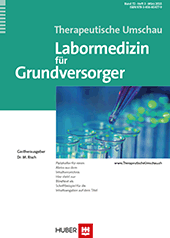Direkte orale Antikoagulantien und Medikamenteninteraktionen
Abstract
Die Vitamin K Antagonisten (beispielsweise Marcoumar) gehören zu den Medikamenten mit den häufigsten Medikamenten- und Nahrungsmittelinteraktionen. Die neueren direkten oralen Antikoagulantien (DOACs) haben diesbezüglich einen potentiellen Vorteil. Bedingt durch ihren Metabolismus zeigen allerdings auch diese neueren Substanzen Interaktionen mit bestimmten Medikamenten. Diese Interaktionen führen zu höheren oder tieferen Plasmaspiegeln und konsekutiv zu einem erhöhten Blutungsrisiko oder einer verminderten Wirksamkeit. Kaum erforscht ist bislang das Interaktionsrisiko von Polymedikationen mit den DOACS. Bei den Vitamin K Antagonisten ist bekannt, dass Patienten mit gleichzeitiger Polymedikation ein deutlich erhöhtes Blutungsrisiko aufweisen. Polymedikation ist häufiger bei älteren Patienten zu finden. Dies ist jedoch auch gerade die Population, die häufiger eine Indikation für eine Antikoagulation hat. Bekannterweise führt eine ganze Reihe von Medikamenten zu Thrombozytenfunktionsstörungen. Es ist sehr wahrscheinlich, dass das Blutungsrisiko bei Einnahme eines DOAC und gleichzeitig bestehender Thrombozytenfunktionsstörung deutlich ansteigt. Dementsprechend ist es unabdingbar, dass bei Verschreibung eines DOACS nicht nur dessen Nebenwirkungspotential, sondern auch jenes der bereits eingenommenen Substanzen berücksichtigt wird und gleichzeitig die Notwendigkeit der Medikation kritisch überprüft wird.
Vitamin K antagonists (VKA) top the list of drugs with most drug and dietary interactions and they are among the medications with the highest incidence of life-threatening events. The new direct oral anticoagulants (DOACs) have been developed to overcome many of the disadvantages of a VKA therapy. Especially, fewer clinically significant drug interactions have been reported to date. However, a number of interactions must be considered. These interactions are linked to the DOAC's specific metabolic pathways. The results of these interactions are changes of the DOAC plasma levels leading either to a higher bleeding risk or to a lower therapeutic efficacy. It is known that patients on VKA and on concomitant polymedication show a higher risk of bleeding. Polymedication is more often found in elderly patients. Patients in this population also have more often an indication for an anticoagulant therapy. Various medications are known to lead to an impaired platelet function. An increase of the bleeding risk in case of a platelet function disorder when additionally taking a DOAC is very likely. Therefore, careful consideration of side effects of both DOAC and concomitant medication when prescribing an anticoagulant therapy is mandatory.



